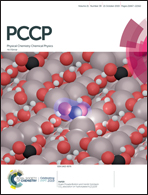Ternary 12-electron CBe3X3+ (X = H, Li, Na, Cu, Ag) clusters: planar tetracoordinate carbons and superalkali cations†
Abstract
Molecules with planar tetracoordinate carbons (ptCs) are exotic in chemical bonding, and they are normally designed according to the 18-electron rule. Here we report on the viability of ptC clusters with as few as 12 valence electrons, which represent the lower limit in terms of electron counting. Specifically, we have computationally designed a class of ternary 12-electron ptC clusters, CBe3X3+ (X = H, Li, Na, Cu, Ag), based on a rhombic CBe32− unit. Computer structural searches reveal that the ptC species are global minima, whose C center is coordinated in-plane by three Be atoms and a terminal X atom via robust C–Be/C–X bonding, either covalent or ionic. The other two X atoms are on the periphery and each bridge two Be atoms. Bonding analyses show that the ptC core is governed by delocalized 2π/6σ bonding, that is, double π/σ aromaticity, which collectively conforms to the 8-electron counting. Additional 4 electrons contribute to peripheral Be–X–Be and Be–Be σ bonding. The delocalized 2π/6σ frameworks appear to be universal for all ptC clusters, ranging from 18-electron down to 12-electron systems. In other words, the ptC species are dictated entirely by the 8-electron counting. Predicted vertical electron affinities of these ptC clusters range from 3.13 to 5.48 eV, indicative of superalkali or pseudoalkali cations.



 Please wait while we load your content...
Please wait while we load your content...